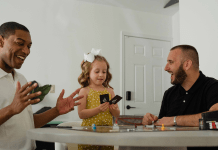Dyslexia is defined “as a learning disability that makes it difficult to read, write, and spell in spite of normal intelligence and adequate instruction.” (Dyslexia Reading Connection, Inc.) Dyslexia is a processing disorder. Dyslexics brains are wired differently; therefore, they need to be taught differently.
One in five people have Dyslexia.
Dyslexia is called the invisible disability which makes things even more challenging. Seeing the early indicators, finding the right interventions and accommodations, and following a reading program gives our children hope and the ability to read.
Early intervention is key. Look and pay attention to these signs when they are little. Also if there is a family history of Dyslexia, then your child has a increased chance of being Dyslexic.
Early Indicators of Dyslexia can include:
Pre-K
– Delayed speech
– Trouble memorizing
– Trouble rhyming
– Mixing up sounds and syllables
Elementary
– Slow when reading, so they guess a lot
– Trouble remembering sight words
– Trouble remembering sequence of steps and events
High School
– Limited vocabulary
– Still confuses “b” and “d”
– Difficulty putting thoughts onto paper
If you suspect your child has Dyslexia, your next step is speaking with their teacher. Ask if your child is displaying the signs/indicators at school that you are witnessing at home. If so, speak with school counselor and the school diagnostician, and they will evaluate the student for a Dyslexia screening. If your school doesn’t have a diagnostician, then go to a licensed educational psychologist, neurologist, or contact your pediatrician for a referral.
If a Dyslexia diagnosis is given…know there is no cure for Dyslexia. There is no magic pill that will fix everything. Dyslexia does not work like that. Strategies, therapies, tutoring, and reading programs will help teach our children a different approach when reading and sounding out words, so they can ultimately read, write, and then spell.
There are many different reading programs and approaches to treating Dyslexia. Some schools use the Multisensory Structured Language Education. This approach “uses sight, sound, movement, and touch to help kids connect language to words.” (www.understood.org) This approach uses all the senses to give a full learning experience, stimulating all the senses in order to learn to read, to write, and to spell. This is just one approach; there are many different programs, all with the same end goal.
On top of starting a reading program at school built just for your child, they will also have specific accommodations made just for them to help with the areas in which Dyslexia affects. Accommodations will change year to year and/if the teacher and parent see a need to adjust.
Here are a few accommodations that have benefitted my daughter: Verbal instructions, highlighted text, auditory tests and quizzes, extended time on assignments and testing, modified assignments, do not count off for spelling errors, testing done one on one or in small groups.
Remember there are many positives about Dyslexia. Here are a few that I just love: out-of-the-box thinkers, creative, have ideas that are quite unique, lively imaginations, big picture thinkers, great problem solvers, empathetic, insightful, ability to be an entrepreneur, curious, great intuition, ambitious, and difference makers, just to name a few. Our children do not follow the crowd, they possess superior reasoning, and see the world and situations differently than others. This is a gift.
There are many famous people that have Dyslexia; inventors, world changers, fashion designers, architects, scientists, and actors/actresses. Here are a few famous people that have “the gift”: Steve Jobs, Richard Branson, Thomas Edison, Henry Ford, Charles Schwab, Johnny Depp, Albert Einstein, John Lennon, and Channing Tatum, to name a few.
Our children cannot be kept in a box. Our children have unique abilities to make and create a different world. Our children can be anything they want to be, just like every other child. They are dreamers. They are doers.
I have shared what our dyslexic children ARE but I want to tell you and society what our children are absolutely NOT. Our children are NOT lazy, NOT stupid, NOT dumb, NOT careless, NOT unmotivated. In fact, our children are the absolute opposite of those negative qualities. Dyslexia is not a weakness, it’s a strength. Our children have a gift. We need to give them the opportunity and resources so our beautiful children can thrive, grow, and share their amazing, unique potential with themselves and the world.
With early intervention, the right reading program, the right accommodations, and of course, the support at school and home, your child will learn to read, learn to love to read, and will thrive, not just try to survive. Our children’s futures are bright. They are not measured by grades or standardized tests. Our children are way much more than reading, writing, and spelling. Never stop advocating, never stop believing. Believe in them and they will believe in themselves, too.













